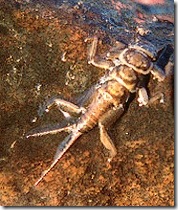 Confirmation of what we’ve always suspected, that with the climb in water temperature due to summer’s heat, and corresponding decline in dissolved oxygen, that stoneflies migrate to the faster flows where the oxygen is again plentiful.
Confirmation of what we’ve always suspected, that with the climb in water temperature due to summer’s heat, and corresponding decline in dissolved oxygen, that stoneflies migrate to the faster flows where the oxygen is again plentiful.
Anyone who’s held a stonefly in still water has seen the gyrations it goes through to force oxygen over its gills, but what is less well known is how nearly everything else changes its behavior in light of warming water and less oxygen.
The probability of the stonefly presence increased significantly with current velocity in summer, but not in winter. Because current influences oxygen renewal rates, our results suggest that the distribution of the insect could be restricted by oxygen.
It’s thought to be one of the triggers for benthic drift, wherein an aquatic population lets loose of their former haunts and drifts to find better water (more food, more oxygen, different temperatures) often during the cooler evening hours where they’re less vulnerable to predators.
Therefore, mayfly nymphs must restrict themselves to a narrow range of habitats where behavioral regulation of oxygen consumption is never required, or they may utilize
less than ideal habitats, changing positions when
necessary during periods of lower oxygen availability.
… and as a response to diminishing oxygen, both mayflies and caddis will crawl out from under to perch on top of the rock – exposing their gills to the full force of the current, versus the lesser currents under the rock.
Experimental investigations in a small artificial stream showed that the positioning of mayfly nymphs (Ephemeroptera) on stones varied with dissolved oxygen concentration (DO). At low DO levels nymphs moved to current-exposed positions, presumably to increase the renewal rate of oxygen at respiratory exchange surfaces.
Making them readily available to foraging fish, and more apt to become dislodged and tumble around, something we love to exploit.
While the nuggets abound poring through the scientific papers, trout season precludes exploiting all of them:
Recorded as a percentage of the total number of items recovered per month, stoneflies account for 47% (December), 82% (January), 70% (February), and 57% (March) of the items consumed. These findings demonstrate the importance of stoneflies in the diet of eastern populations of trout during the winter months.
January appears to be the month for the “fattened calf” as the bigger stoneflies appear to be markedly favored by trout. Perhaps the turbidity associated with winter storms makes all but the larger bugs less visible, but 82% is a mighty compelling number.
Tags: Stonefly nymphs, benthic drift, mayfly, caddis, dissolved oxygen, trout fishing, fly fishing

Sweet! Ver modern, ver high tech. (translate = consumption data for plecoptera in a maryland stream is extremely useful material. I wonder if similar studies could be done by daily drift sampling in my favorite rivers and if someone would pay me to do it.)